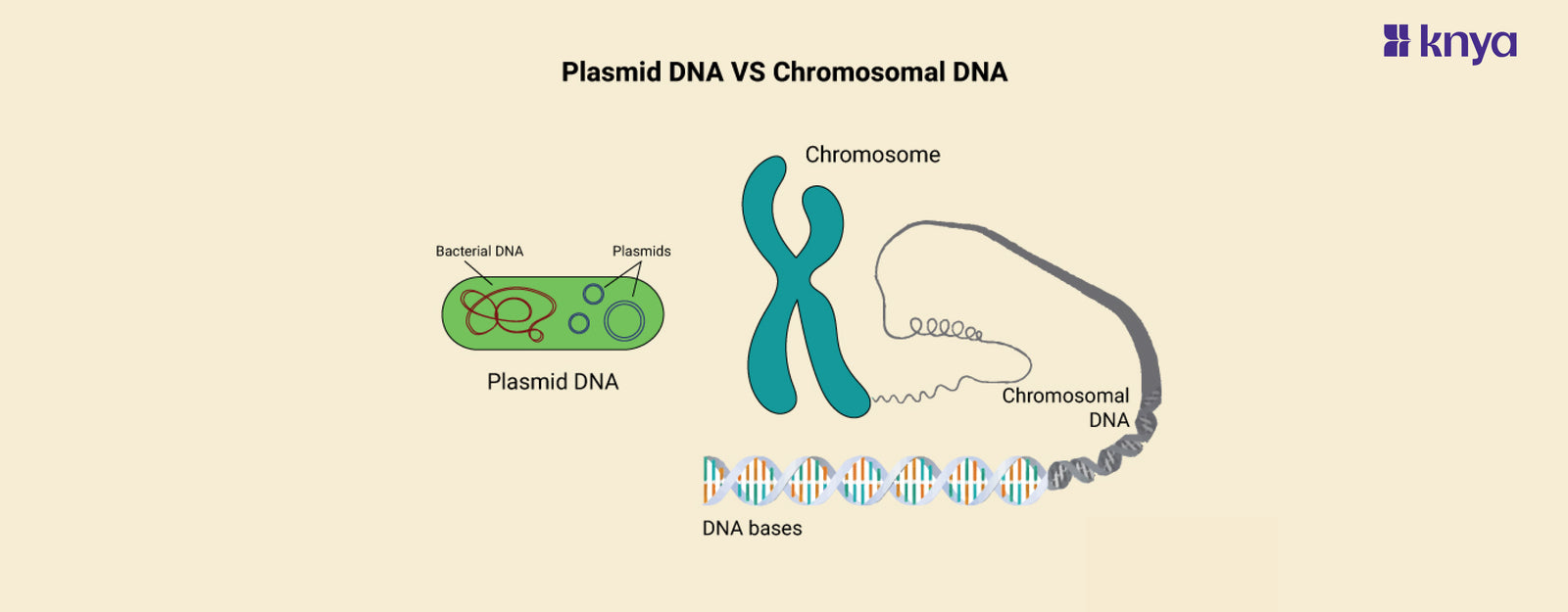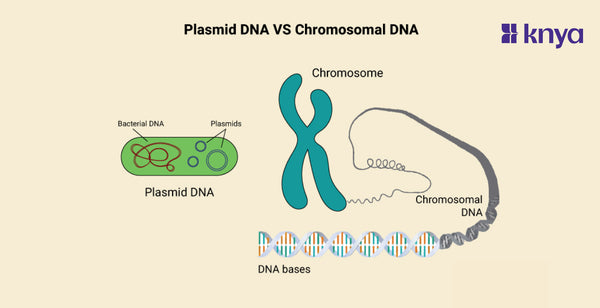Difference Between Plasmid DNA and Chromosomal DNA: Chromosomal DNA, the blueprint of life, is found in the nucleus and controls cellular activity and organismal features. This double-stranded, linear (in eukaryotes) or circular (in prokaryotes) molecule encodes genes necessary for growth, development, and reproduction. Plasmid DNA, a tiny, generally circular, double-stranded molecule, exists independently and contains non-essential genes such as antibiotic resistance. They multiply independently, can be moved across cells, and have enormous promise for genetic engineering by acting as vectors to introduce new genes into animals.
Difference Between Plasmid DNA and Chromosomal DNA
Cells contain two different forms of genetic material: chromosomal DNA and plasmid DNA. These are the differences between Plasmid DNA and Chromosomal DNA.
|
Feature |
Chromosomal DNA |
Plasmid DNA |
|
Location |
Found in the nucleus (eukaryotes) or nucleoid region (prokaryotes). |
Located outside the chromosomal DNA, typically in the cytoplasm. |
|
Structure |
Forms the main structure of the chromosome, with genes and regulatory elements. |
Circular or linear DNA, separate from the main chromosomal DNA, often containing accessory genes. |
|
Copy Number |
Usually present in a single copy per cell. |
Can exist in multiple copies within a single cell. |
|
Size |
Larger, containing a vast number of genes and non-coding regions. |
Smaller, with a limited number of genes. |
|
Inheritance |
Inherited through sexual reproduction or cell division. |
Can be inherited independently of chromosomal DNA and can be transferred between cells through horizontal gene transfer mechanisms like conjugation. |
|
Essentiality |
Essential for the survival and basic functions of the organism. |
Often carries accessory genes that may provide additional functions but are not essential for basic cellular processes. |
|
Replication Origin |
Replicates from a single origin of replication. |
Contains its own origin of replication, allowing it to replicate independently of the chromosomal DNA. |
|
Genetic Content |
Contains essential genes for cellular functions and traits. |
May carry genes for specific functions, such as antibiotic resistance, toxin production, or metabolic pathways. |
|
Transferability |
Generally not transferred between cells. |
Can be transferred horizontally between bacteria during processes like conjugation. |
|
Evolutionary Role |
Central to the long-term evolutionary changes in an organism. |
Can contribute to the adaptability and evolution of a population by providing a means for sharing beneficial genes. |
Browse Best Scrubs Collection
What is Plasmin DNA?
Think of it as the optional add-ons for your life instructions. This circular, mini-DNA molecule exists alongside the main chromosomes in bacteria and some other organisms. It carries extra genes for traits like antibiotic resistance or toxin production, not essential but offering a bonus. Plasmids can replicate independently and even hop between cells, making them fascinating tools for research and genetic engineering.
Key Features of Plasmid DNA:
- Plasmids are much smaller than chromosomes, usually ranging from a few hundred to a few thousand base pairs. They exist as closed, circular loops of double-stranded DNA, offering a unique topological structure compared to linear chromosomes.
- Plasmids reproduce independently from the host cell's chromosome, utilising their own replication sources. This enables them to reproduce faster than chromosomal DNA and exist in numerous copies inside the same cell.
- Plasmids frequently contain genes that give non-essential functions to the host cell, such as antibiotic resistance or the capacity to metabolise certain substances. These can provide survival benefits in some circumstances.
- Plasmids may be transmitted across cells, even between species, using a process known as conjugation. This allows genes to expand beyond standard vertical inheritance via reproduction.
What is Chromosomal DNA?
This is the core set, the building block that is needed to build and maintain an organism. Instructions for all aspects of life, including growth and development and reproduction, are contained in chromosomes, which are circular or linear strands of DNA loaded with essential genes. To guarantee precise inheritance, they are meticulously duplicated and arranged in a tidy manner throughout cell division. Modifying chromosomal DNA can have significant effects on an organism's ability to survive, unlike plasmids.
Key Features of Chromosomal DNA:
- Chromosomes are significantly larger than plasmids, containing millions to billions of base pairs. They exist as linear, double-stranded molecules organized in specific territories within the nucleus.
- Chromosomal DNA replication is strictly controlled and synchronised with the cell cycle. This guarantees correct duplication and avoids mistakes that might cause genetic instability.
- Chromosomes contain the genes required for basic cellular activities and the organism's development. These genes control protein synthesis, cell division, and the expression of certain features.
- During cell division, chromosomal DNA is transmitted from parent to offspring, ensuring that genetic information is carried on across generations. This is critical to the survival and evolution of species.
Shop Best Lab Coats from Here!
Similarities Between Plasmid DNA and Chromosomal DNA
- Composition: Both Plasmid DNA and Chromosomal DNA are composed of nucleotide sequences containing adenine (A), thymine (T), cytosine (C), and guanine (G).
- Genetic Code: Both encode genetic information using the same universal genetic code.
- Replication: Both undergo processes of DNA replication to ensure the transmission of genetic material to daughter cells during cell division.
- Function: Both play roles in determining the traits and characteristics of an organism.
- Transmission to Offspring: Both can be transmitted to offspring during reproduction, ensuring the continuity of genetic information.
| Check out More Articles | |
| Difference Between Cartilage and Bone | |
| Difference Between Endocrine and Exocrine Glands | |
| Difference Between Cell Wall and Cell Membrane | |















